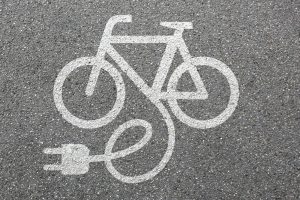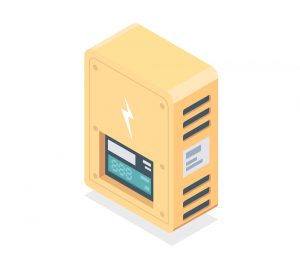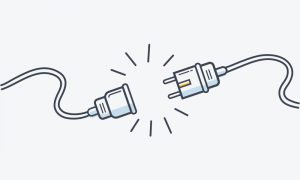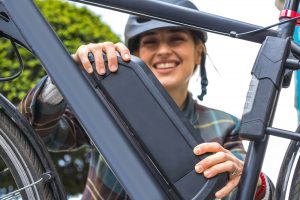
E-bikes are rising in popularity once again, owing to various reasons like the pandemic and increased awareness about the dangerous levels reached by the global carbon footprint. More and more people and companies are shifting towards clean energy production while introducing products that can help consumers move on from unsustainable practices without facing inconveniences. If you’re looking forward to getting an electric bike yourself, it would be helpful if you did some research about it beforehand. It will give you a good idea about the pros and cons of e-bikes as well as how you can adapt to, and overcome various issues you might come across when using them. When talking about e-bikes, it’s a given that you touch on the subject of clean energy as well. If you’re using electricity produced through fossil burners, the whole point of buying an e-bike for clean energy will be moot. However, you can use solar energy to charge your e-bike battery. This article will be discussing how you can utilize MPPTs to charge your e-bike battery with solar energy, what you’ll need to get it done, as well as the mechanics behind it.
Can I Connect An MPPT Directly To An E-Bike Battery?

The simple answer to that is yes, it is possible. However, it depends on several factors like the MPPT (maximum power point tracker) controller for instance. Many MPPT step-up converters can convert your higher panel voltage into a suitable voltage to charge your battery. Furthermore, the voltage and battery type needed for the controller to work should be checked as a range of different MPPT controllers are available for you to choose from and you should get one that suits your controller. For example, a battery voltage of either 12/24 or 48V is fine for an MPPT 100/20-48V controller but the voltage may differ if an MPPT 75/10 is used. Moreover, an ultra-fast MPPT controller will be very useful even on a gloomy day as it will improve energy harvest even if the light intensity fluctuates throughout the day.
Required Materials And Finding The Suitable Type For Your E-Bike Battery
There are three main components that you will need to connect an MPPT directly to an e-bike battery. They are the MPPT, solar panels, as well as adapter cables.
MPPT

Before you proceed, the first thing you need to do is to check the battery specifications for your e-bike as they may differ depending on the type of e-bike you have and the brand. The main details you need to know to precisely determine which MPPT you need are the number of cells, peak voltage, and maximum charge power. The reason why these details are important is that the MPPT is the main component that is used to boost the voltage, and it has to be done according to the specific battery requirements after taking input from the solar panels. If you get inaccurate specifications it can result in instances where some batteries can be dangerous and explosive as well as damaging to your e-bike due to there being a slight mismatch.
In addition to that, since the MPPT is the core of the system, you need to make sure to not put too much amperage through the controller. Before you set everything up you will also need a solar panel, adapter cables, and inline meters that are necessary to measure voltage and amperage from the boost MPPT. Make sure you are using the correct adapter and amp rating for your panel and controller respectively, before starting.
Solar Panel

You need to know the type of solar panel to use too, since some solar panels only put out under 20V, even on a sunny day. This is because they are typically designed to charge 12V batteries. As the voltage required to charge an e-bike is mostly 36V or 48V, you will need a solar panel that can charge an e-bike battery after it is connected to an MPPT. For example: if the voltage for your e-bike is 48V, you should be able to provide a higher voltage for charging. Therefore, you would need a large enough panel/s(possibly 2 x 100 Watts, 2 x 4 feet each) to charge a fully depleted e-bike in a short period. You will also need to look into the cost of these solar panels and see your affordability range.
Furthermore, you will need to install an MPPT capable of at least 48~60 volts to regulate the solar charge so that it can turn off when the battery is fully charged. It is essential that the MPPT controller you will be using, can fully charge the battery as the battery will continually wane between a ‘partially charged’ and the ‘end of discharge’ state if not charged to its full capacity. This will eventually damage the battery within weeks or months.
Another point you need to consider is if your e-bike can be solar charged while riding it. Many manufactured bikes cannot do this as the e-bike’s BMS disables the electric assist when the charger is in “Charging mode”. Firstly, put this theory to the test, if the e-bike works like normal while charging, you will be able to ride and charge simultaneously, however, if the electric assist is disabled while charging, you can’t ride and charge at the same time but you can still charge when not riding. Secondly, you will need to look at the charging ports. If you are charging via an existing charging port, look at the pins. You need to look for any data pins in your e-bike charger. If there are no data pins, you’re in luck. You will be able to use the existing charging port to solar charge your e-bike with ease.
Adapter cables

The third most important thing you need to buy is the right adapter cables to connect the solar panel to the charge controller. As simple as it may seem to easily connect some wires, you need the right cables as well to connect everything as well as the right connecting order. You must read the charge controller instructions to get the right connection order. Some MPPTs require connecting the battery and charge controller first. While other charge controllers recommend that you join the solar panel and MPPT first. However, if your battery and the charge controller have the same connectors, an adapter cable isn’t necessary. As you will be keeping the solar panel outside it is advisable to put an extension cable between the solar panel and MPPT. That way your adapter cable can connect to the charger and panel while your e-bike stays indoors.
Setting up the MPPT to your e-bike battery

Now that you have everything at hand, the last thing to do is set everything up. If you would like to know the duration it takes to charge your e-bike you can look for a Solar panel Charge time calculator online. This will give you a rough estimate of the number of hours it will take to charge under direct sunlight according to the battery (type, amp-hours, voltage), solar panel wattage, and controller type.
It will be quite difficult for you if your electric bike has data pins though, in that case, you should seek professional advice to mimic that data signal as mentioned before dealing with batteries can be dangerous.
There are several things that you need to be aware of when charging your battery since e-bike batteries are prone to get damaged rather easily and will require replacements which can be pretty expensive. One of them is to avoid letting your battery sit around in a depleted state for too long as it will make the battery die and not rechargeable. Another is to avoid overcharging. You must also make sure to keep it away from water and extreme temperatures. E-bike batteries can also be damaged due to physical exertion.
Alternative Method

If you are unable to use an MPPT and are looking for an alternative method that works for your e-bike, you can try Solar generators. This has a similar setup to the previous technique. The solar generator regulates the solar energy and comes with a battery that stores energy and an inverter that converts to AC for your AC devices.
Conclusion

If you are looking to charge your e-bike battery with solar power then an MPPT is an essential component. MPPT maximizes the power output of the solar panel to the e-bike battery. The MPPT results in efficient charging and quicker charging rates. An MPPT can be directly connected to an e-bike battery with the help of adapter cables. Just as with any other high-power device you need to be extra cautious when working with MPPTs. Connecting an MPPT to an e-bike battery without checking the specifications could fry your battery and waste 100s and 1000s of dollars. Make sure you pay special attention to the critical voltage ratings of your e-bike battery and ensure your MPPT is compatible.
